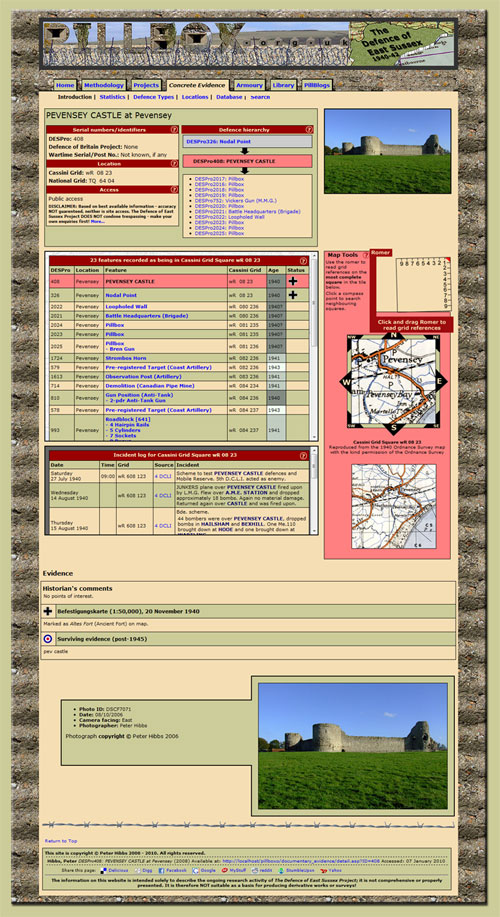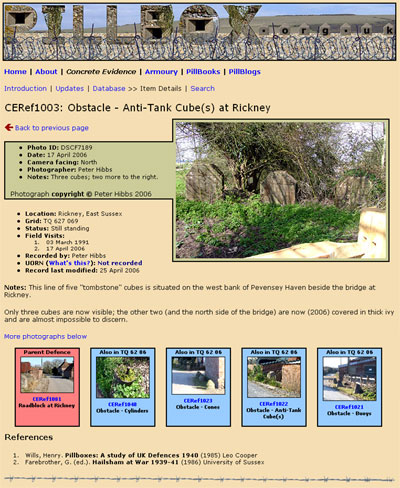Concrete Evidence relaunch!
Posted: 13 January 2010 19:36
I've been working especially hard on the database side of things since July; progress has been such that I'm now able to relaunch Concrete Evidence.
The original database dates right back to 2006 and was rarely modified because it was a somewhat awkward process to do so. I then began researching documents, and to store data concerning defences works listed in them, I created a new database, Documentary Evidence, in 2008. This was based on, but was also a development of, Concrete Evidence, and the two sat side-by-side; CE listed surviving works, DE recorded what the documents said.
By 2009, I was no longer satisfied with Concrete Evidence as it did not reflect the latest advances of my research such as were evident in the private Documentary Evidence. As having two separate databases both storing similar types of data was not very sensible, I have now merged the two into a single database. The surviving works from CE (some of which were now being duplicated in DE) have been combined with the more technically-advanced DE.
So what's new?
There have been some changes to the original Concrete Evidence records:
- Non-East Sussex records have been removed to reflect the scope of the Project.
- One or two records were 'howlers' not adequately supported by evidence; these have been removed.
- Abstract defences (e.g. Sub-sectors) have been removed.
- Obstacles (cubes, pimples, cylinders and buoys) have been unified under their parent roadblock (where identified) as a single record, rather than as separate records for each type of obstacle; they can still be found in the database by their type, however.
- The original CERef record identifiers have been replaced by DESPro (Defence of East Sussex Project) IDs.
- As there is now only one main project database, public access to it is restricted to certain records only!
The latter is a very important point; I no longer have a separate 'public' database and a main private one. Concrete Evidence is now one database with two levels of access. At this moment in time, 120 records are public, out of a total of 2169 in the full database; new records can be released as and when appropriate by simply updating one database. The reason for witholding the majority of the information is to protect my research.
The power of Documentary Research

This is as good a place as any to repeat my call for the use of archive documents in such research projects.
A quick comparison of old and new Concrete Evidence record pages shows how using original sources has impacted on my research.
On the right is the new page, packed with all sorts of data.
Now view the screeenshot below from 2006 - this is from a time when my methodology was nothing more than using secondary sources and blindly wandering the countryside in search of evidence.
In those days, I was struggling to find information to add to the database, and it shows.
Today the problem is far too much information, which is why the new record screen is absolutely crammed full.

The documents have now begun to realise my vision of reconstructing the defences by filling in the gaps in the historical record and creating a 3D picture of East Sussex that we can also track across time.
This new version of Concrete Evidence represents a major milestone in the Defence of East Sussex Project; I now have the database and information structure to cope with the enormous amount of data generated by my research. After 2 years of system development, the sprint of the last six months means that I can now concentrate fully on harvesting the data from the documents and enter it into the database and let the technology do the hard work!
- Pete

Email:
Blog Latest

Bishopstone reveals its pillbox secrets
18 October 2021

Pillbox or Observation Post?
10 June 2020

Uncovering the hidden secrets of a pillbox
8 June 2019

Review of 2018
31 December 2018

Wartime Christmas in East Sussex (2)
24 December 2018
Jargon-buster
Buoys
Small concrete roadblock obstacle comprising a truncated cone with domed base. A hollow shaft down the centre allowed the buoy to be manhandled using a crowbar. Buoys were deemed of little value by 1941 and cylinders seen as a better solution.
Cubes
Anti-tanks blocks, popularly known as dragon's teeth. Not to be confused with smaller blocks known as pimples, cubes can be upwards of 1m square. Many examples in Sussex have apexes or chamfered edges, leading to them being incorrectly recorded as coffins.
Cylinders
Reinforced concrete cylindrical obstacles with a shaft down the centre in which could be inserted a crowbar for manhandling, or a picket for barbed wire. Cylinders were 90cm high and 60cm wide and deployed in groups of three as a more effective alternative for buoys.
DESPro
The Defence of East Sussex Project.

Pimples
Small anti-tank block in the form of a truncated pyramid. Pimples were used to extend anti-tank obstacles and roadblocks and were intended for use on soft ground.
This site is copyright © Peter Hibbs 2006 - 2024. All rights reserved.
Hibbs, Peter Concrete Evidence relaunch! (2024) Available at: http://www.pillbox.org.uk/blog/216649/ Accessed: 26 April 2024
The information on this website is intended solely to describe the ongoing research activity of The Defence of East Sussex Project; it is not comprehensive or properly presented. It is therefore NOT suitable as a basis for producing derivative works or surveys!